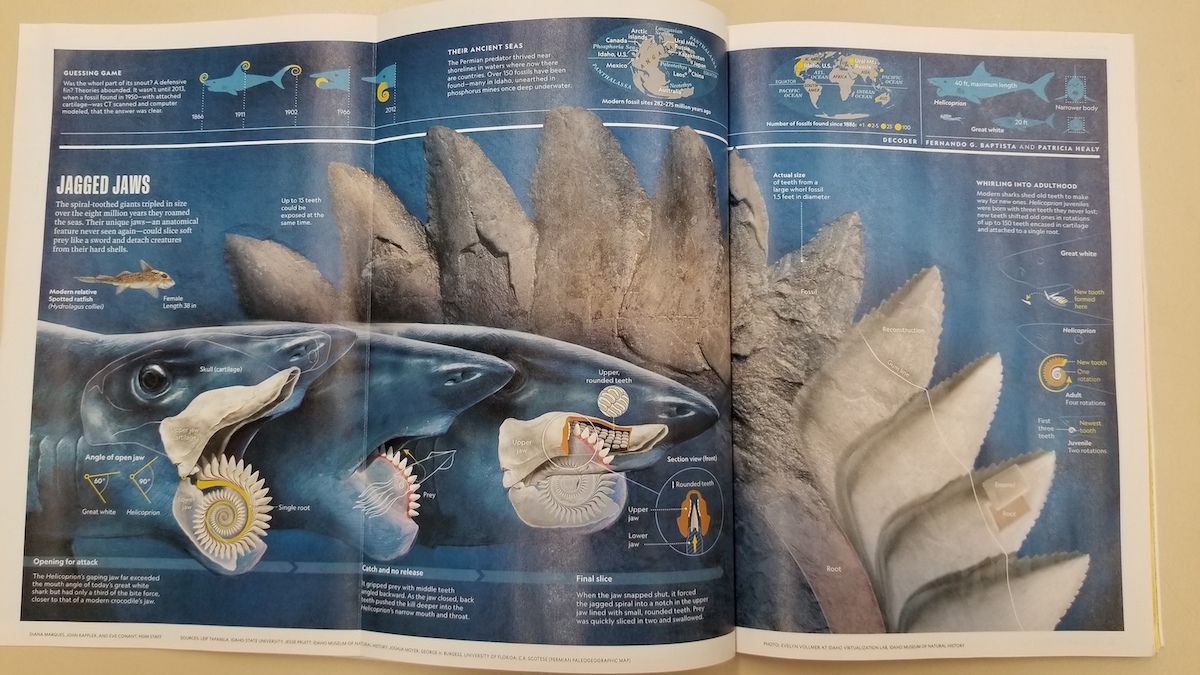Idaho Museum of Natural History’s buzzsaw sharks featured story in December National Geographic Magazine
December 5, 2019

POCATELLO – Idaho Museum of Natural History Director Leif Tapanila is ecstatic that Helicoprion sharks, the focus of an Idaho Museum of Natural History exhibit “The Buzzsaw Sharks of Idaho,” are the centerfold story in the December 2019 National Geographic magazine.
“We are pretty excited about our buzzsaw sharks having the center tri-fold in this month’s magazine,” said Leif Tapanila. “It is a treat to see it get the centerfold.”
Tapanila, Idaho Virtualization Laboratory Manager Jesse Pruitt and museum Career Path Intern Evelyn Vollmer have been working with National Geographic staff for weeks on the story that appears this month, that includes social media promotions by National Geographic Magazine. They were recognized as “source credits” in the article.
“One of the nice things about working with National Geographic is they want to get it as right as possible,” Tapanila said. “They’ve come back with corrections, bouncing back-and-forth with us on a nearly daily basis to try to nail it down.”
Given all the national and international attention these sharks have garnered, Tapanila encourages members of the local community to enjoy the “Buzzsaw Sharks of Idaho” exhibit at the museum that will be taken down in mid-January.
“If you haven’t had the chance to see the exhibit, come out during the holidays, it will be taken down in mid-January,” Tapanila said. “We really want people to see it if they haven’t had a chance, especially if they have family in town for holidays. It is one of Idaho’s best stories.”
This unique exhibit combines science, art, music, and humor to tell the story of the strange Helicoprion shark of 270 million years ago. Although the fossil has been found worldwide since the 1800s, it is Idaho where the greatest number and quality of Helicoprion fossils are unearthed in the phosphate mines between Soda Springs and Pocatello. The Idaho Museum of Natural History is home to the single largest collection, now exceeding 85 specimens.
“Our studies on Helicoprion show it was the largest predator on earth at the time, nearly 270 million years ago,” Tapanila said. “This is Idaho’s most spectacular monster.”
The exhibit presents a wide array of spectacular Helicoprion fossils integrated with original artworks by Alaskan artist, Ray Troll. Also featured are dramatic life-sized models of the shark, a mechanical interactive jaw, children’s activities, original music, a short documentary and more.
The Idaho Museum of Natural History has been serving Idaho since 1934. To learn more about the museum, please visit imnh.isu.edu.
For those with an Instagram account, the National Geographic promotional video for this story is located at https://idahostateu.com/
Categories:
